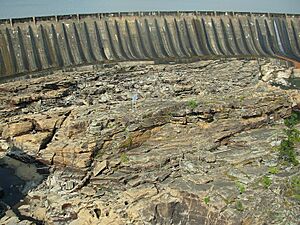Tallassee, Alabama facts for kids
Quick facts for kids
Tallassee
|
||
|---|---|---|
|
City
|
||
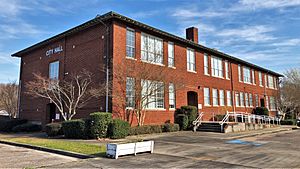
Tallassee City Hall in 2021
|
||
|
||
| Nickname(s):
"Treasure on the Tallapoosa"
|
||
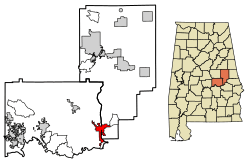
Location of Tallassee in Elmore County and Tallapoosa County, Alabama.
|
||
| Country | United States | |
| State | Alabama | |
| Counties | Elmore, Tallapoosa | |
| Incorporated | October 24, 1835 | |
| Area | ||
| • Total | 12.19 sq mi (31.58 km2) | |
| • Land | 11.37 sq mi (29.44 km2) | |
| • Water | 0.83 sq mi (2.14 km2) | |
| Elevation | 390 ft (119 m) | |
| Population
(2020)
|
||
| • Total | 4,763 | |
| • Density | 418.98/sq mi (161.77/km2) | |
| Time zone | UTC-6 (CST) | |
| • Summer (DST) | UTC-5 (CST) | |
| ZIP codes |
36045, 36078
|
|
| Area code(s) | 334 | |
| FIPS code | 01-74688 | |
| GNIS feature ID | 0153643 | |
| Website | http://www.tallassee-al.gov | |
Tallassee (pronounced /ˈtæləsi/) is a city in Alabama, USA. It's special because it sits on the Tallapoosa River and is located in two different counties: Elmore and Tallapoosa. In 2020, about 4,763 people lived here. Tallassee is also home to a big hydroelectric power plant at Thurlow Dam, which makes electricity from the river's water.
Tallassee is part of the larger Montgomery area.
Contents
History
Early History and Native American People
The area where Tallassee is located was once home to the historic Creek people. They are thought to be descendants of the Mississippian culture, who lived in the Southeast from about 1000 to 1450. These people were known for building large earthwork mounds. They used these mounds for important political and religious events. They also relied a lot on fishing and trading along the rivers.
The Creek word for "Old Town" is Talisi. This was the name of a town in the Coosa Province of the Mississippian culture. A Spanish explorer named Hernando de Soto visited it in 1540. Later, the historic Creek people lived there. The Tallassee area was also where the Creek capital city, Tuckabatchee, was located.
The Creek Wars
The Creek Wars (1813–1814) were a difficult time with many battles. They started as a civil war among the Creek people, but US forces also became involved. One important leader, Osceola, is believed to have been born in Talisi. He was a Creek who later moved to Florida and became a leader of the Seminole Indians. He continued to fight against US forces.
The last major battle of the Creek Wars happened in 1814 at Horseshoe Bend, right on the Tallapoosa River. General Andrew Jackson led a group of soldiers and Native American allies against the Creek. Jackson's victory helped him become very popular. After their defeat, many Creek people were forced to move to Indian Territory (which is now Oklahoma). Some of them named a new settlement Talisi, which later became Tulsa, Oklahoma.
Tallassee During the Civil War
During the American Civil War (1861-1865), Tallassee played an important role for the Confederate army. A company in Tallassee, Barnett, Micou, and Company, made cloth for Confederate uniforms and tents.
In 1864, the Confederate army moved a factory that made carbines (a type of rifle) from Virginia to an old cotton mill in Tallassee. This factory started making weapons. Tallassee was never attacked by Union forces during the war, except for one attempt to destroy the mill. The Tallassee Armory was the only Confederate armory that was not destroyed during the war.
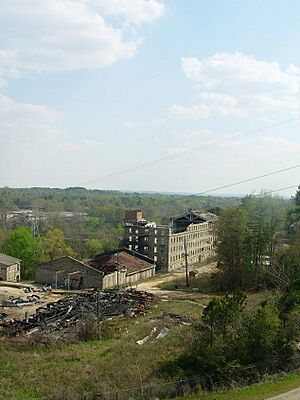
The Mills of Tallassee
The textile mills were a big part of Tallassee's history. In 1900, the Tallassee Falls Manufacturing Company became part of a larger company called Mount Vernon-Woodberry Cotton Duck Company. This company owned many mills across different states.
Like many factories at the time, children also worked in the Tallassee Mills until the 1930s. The houses on King Street, which are still there today, were built around 1863 for the families of the officers in charge of the armory and the mill. Sadly, the Mount Vernon Mill in Tallassee was completely destroyed by a fire in 2016.
The "long bell" has been rung in Tallassee every day except Sunday at 4:30 AM since the early days of the mills. This bell was rung to signal the start of the workday for the mill workers. Even today, visitors might be surprised to wake up to the sound of the bell!
Geography
Tallassee is located at 32°32′22″N 85°53′35″W / 32.53944°N 85.89306°W. The city covers about 10.2 square miles (26.4 km2). Most of this area is land, with a small part being water.
Tallassee is in the Emerald Mountains, which are a small chain of the Lower Appalachians. Two major rivers are nearby: the Coosa River to the west and the Tallapoosa River to the east. The Tallapoosa River also divides the city into two parts: Tallassee in Elmore County and East Tallassee in Tallapoosa County.
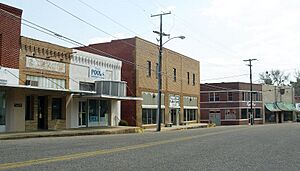

The Alabama Power Company built three power plants along the Tallapoosa River between 1923 and 1933. These plants, called Thurlow Dam, Yates Dam, and Martin Dam, use the river's water to create a lot of electricity.
Tallassee has two main highways: State Highway 14 and State Highway 229. The Tallassee Municipal Airport serves smaller planes.
Population Information
| Historical population | |||
|---|---|---|---|
| Census | Pop. | %± | |
| 1880 | 1,182 | — | |
| 1890 | 1,413 | 19.5% | |
| 1910 | 1,347 | — | |
| 1920 | 2,034 | 51.0% | |
| 1930 | 843 | −58.6% | |
| 1940 | 1,011 | 19.9% | |
| 1950 | 4,225 | 317.9% | |
| 1960 | 4,934 | 16.8% | |
| 1970 | 4,809 | −2.5% | |
| 1980 | 4,763 | −1.0% | |
| 1990 | 5,112 | 7.3% | |
| 2000 | 4,934 | −3.5% | |
| 2010 | 4,819 | −2.3% | |
| 2020 | 4,763 | −1.2% | |
| U.S. Decennial Census 2013 Estimate |
|||
As of the 2020 census, Tallassee had 4,763 people. The city has a mix of different backgrounds. About 68.8% of the people were White, and 23.18% were Black or African American. Other groups included Native American, Asian, Pacific Islander, and people of two or more races. About 2.83% of the population was Hispanic or Latino.
Media and Communication
Newspapers
The Tallassee Tribune has been the local weekly newspaper since 1899. It started as the Tri-County Weekly, then became the Tallassee Times, and finally The Tallassee Tribune in 1912. It comes out every Wednesday and shares news for the Tallassee area.
Tallassee Times is also an online news source that started in 2008. It gets thousands of views each week. They even have a Tallassee Times TV webcam channel that shows local events, like Tallassee Tiger sports.
Radio
Tallassee has three radio stations:
- WTLS (1300 AM / 106.5 FM) plays news and sports.
- WALQ (1130 AM / 101.1 FM) plays oldies music.
- WQNR (99.9 FM) "Kate FM" is licensed to Tallassee but broadcasts from nearby Auburn, Alabama.
Education
The Tallassee City School System serves most of the city's students. This school system was started in 1915. It has three schools: Tallassee High School, Southside Middle School, and Tallassee Elementary School. About 2,000 students attend these schools, and there are around 112 teachers.
Healthcare
The Community Hospital in Tallassee was built in 1926. It is a non-profit hospital with sixty-nine beds. It provides healthcare services to people in Elmore, Tallapoosa, and Macon counties.
Climate
Tallassee has a humid subtropical climate. This means it has hot, humid summers and winters that are generally mild to cool.
Notable People
Many interesting people have connections to Tallassee:
- Derrick Ansley, an NFL coach
- Antoine Caldwell, a former NFL offensive lineman
- Peter McQueen, a Creek Indian chief, prophet, trader, and warrior
- Mike Morgan, a former NFL running back
- Opothleyahola, a Creek Indian chief
- Michael Ritch, a professional soccer striker
- Charles Davis Tillman, a singer-songwriter who helped create the southern gospel music style
- Demond Washington, a professional football cornerback
- Ned Cobb, a sharecropper who was the subject of the book All God’s Dangers
Recreation
The Tallassee Recreation Department helps keep the community active. They manage three main places for fun:
- A public swimming pool
- A public playground
- A park
- The main recreation building, which has a basketball court and a weight room.
The department also offers and supports many sports programs for young people.
Images for kids
-
Mt. Vernon Mills on the east side of the Tallapoosa River pictured in 2010.
-
Post Office (ZIP code: 36078)
See also
 In Spanish: Tallassee (Alabama) para niños
In Spanish: Tallassee (Alabama) para niños




